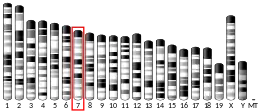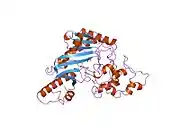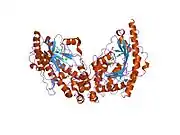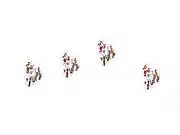| CKM | |||||||||||||||||||||||||||||||||||||||||||||||||||
|---|---|---|---|---|---|---|---|---|---|---|---|---|---|---|---|---|---|---|---|---|---|---|---|---|---|---|---|---|---|---|---|---|---|---|---|---|---|---|---|---|---|---|---|---|---|---|---|---|---|---|---|
| |||||||||||||||||||||||||||||||||||||||||||||||||||
| Identifiers | |||||||||||||||||||||||||||||||||||||||||||||||||||
| Aliases | CKM, CKMM, M-CK, creatine kinase, M-type, CPK-M | ||||||||||||||||||||||||||||||||||||||||||||||||||
| External IDs | OMIM: 123310 MGI: 88413 HomoloGene: 20432 GeneCards: CKM | ||||||||||||||||||||||||||||||||||||||||||||||||||
| |||||||||||||||||||||||||||||||||||||||||||||||||||
| |||||||||||||||||||||||||||||||||||||||||||||||||||
| |||||||||||||||||||||||||||||||||||||||||||||||||||
| |||||||||||||||||||||||||||||||||||||||||||||||||||
| |||||||||||||||||||||||||||||||||||||||||||||||||||
| Wikidata | |||||||||||||||||||||||||||||||||||||||||||||||||||
| |||||||||||||||||||||||||||||||||||||||||||||||||||
Creatine kinase, muscle also known as MCK is a creatine kinase that in humans is encoded by the MCK gene.[5]
Structure
In the figure to the right, the crystal structure of the muscle-type M-CK monomer is shown. In vivo, two such monomers arrange symmetrically to form the active MM-CK enzyme.
Function
The protein encoded by this gene is a cytoplasmic enzyme involved in cellular energy homeostasis. The encoded protein reversibly catalyzes the transfer of "energy-rich" phosphate between ATP and creatine and between phospho-creatine and ADP. Its functional entity is a MM-CK homodimer in striated (sarcomeric) skeletal and cardiac muscle.
Clinical significance
In heart, in addition to the MM-CK homodimer, also the heterodimer MB-CK consisting of one muscle (M-CK) and one brain-type (B-CK) subunit is expressed. The latter may be an important serum marker for myocardial infarction, if released from damaged myocardial cells into the blood where it can be detected by clinical chemistry.
References
- 1 2 3 GRCh38: Ensembl release 89: ENSG00000104879 - Ensembl, May 2017
- 1 2 3 GRCm38: Ensembl release 89: ENSMUSG00000030399 - Ensembl, May 2017
- ↑ "Human PubMed Reference:". National Center for Biotechnology Information, U.S. National Library of Medicine.
- ↑ "Mouse PubMed Reference:". National Center for Biotechnology Information, U.S. National Library of Medicine.
- ↑ Rosenberg UB, Kunz G, Frischauf A, Lehrach H, Mähr R, Eppenberger HM, Perriard JC (November 1982). "Molecular cloning and expression during myogenesis of sequences coding for M-creatine kinase". Proc. Natl. Acad. Sci. U.S.A. 79 (21): 6589–92. Bibcode:1982PNAS...79.6589R. doi:10.1073/pnas.79.21.6589. PMC 347173. PMID 6959139.
Further reading
- Zhao TJ, Yan YB, Liu Y, Zhou HM (2007). "The generation of the oxidized form of creatine kinase is a negative regulation on muscle creatine kinase". J. Biol. Chem. 282 (16): 12022–9. doi:10.1074/jbc.M610363200. PMID 17303563.
- Yamin C, Amir O, Sagiv M, et al. (2007). "ACE ID genotype affects blood creatine kinase response to eccentric exercise". J. Appl. Physiol. 103 (6): 2057–61. CiteSeerX 10.1.1.541.1252. doi:10.1152/japplphysiol.00867.2007. PMID 17885020. S2CID 1453408.
- Warren GL, O'farrell L, Rogers KR, et al. (2006). "CK-MM autoantibodies: prevalence, immune complexes, and effect on CK clearance". Muscle Nerve. 34 (3): 335–46. doi:10.1002/mus.20594. PMID 16810680. S2CID 27846751.
- Hemmer W, Wallimann T (1993). "Functional aspects of creatine kinase in brain". Dev. Neurosci. 15 (3–5): 249–60. doi:10.1159/000111342. PMID 7805577.
- Vikenes K, Andersen KS, Melberg T, et al. (2009). "Long-term prognostic value of creatine kinase-myocardial band mass after cardiac surgery in low-risk patients with stable angina". Cardiology. 113 (2): 122–31. doi:10.1159/000177949. PMID 19039220. S2CID 20448393.
- Muniesa CA, González-Freire M, Santiago C, et al. (2008). "World-class performance in lightweight rowing: Is it genetically influenced? A comparison with cyclists, runners and non-athletes". Br J Sports Med. 44 (12): 898–901. doi:10.1136/bjsm.2008.051680. PMID 18801770. S2CID 32530870.
- Wyss M, Kaddurah-Daouk R (2000). "Creatine and creatinine metabolism". Physiol. Rev. 80 (3): 1107–213. doi:10.1152/physrev.2000.80.3.1107. PMID 10893433.
- Finsterer J, Stöllberger C, Krugluger W (2008). "Significance of CK-elevation in noncompaction with regard to cardiac and neuromuscular disease". Int. J. Cardiol. 130 (2): 174–9. doi:10.1016/j.ijcard.2007.08.038. PMID 18055044.
- Fautsch MP, Vrabel AM, Johnson DH (2006). "The identification of myocilin-associated proteins in the human trabecular meshwork". Exp. Eye Res. 82 (6): 1046–52. doi:10.1016/j.exer.2005.09.016. PMID 16289162.
- Heled Y, Bloom MS, Wu TJ, et al. (2007). "CK-MM and ACE genotypes and physiological prediction of the creatine kinase response to exercise". J. Appl. Physiol. 103 (2): 504–10. doi:10.1152/japplphysiol.00081.2007. PMID 17478608. S2CID 25125082.
- Kelley WE, Lockwood CM, Cervelli DR, et al. (2009). "Cardiovascular disease testing on the Dimension Vista system: biomarkers of acute coronary syndromes". Clin. Biochem. 42 (13–14): 1444–51. doi:10.1016/j.clinbiochem.2009.05.020. PMID 19523464.
- Wang PF, Flynn AJ, Naor MM, et al. (2006). "Exploring the role of the active site cysteine in human muscle creatine kinase". Biochemistry. 45 (38): 11464–72. doi:10.1021/bi0607002. PMC 2556515. PMID 16981706.
- Eeg-Olofsson O, Kalimo H, Eeg-Olofsson KE, et al. (2008). "Duchenne muscular dystrophy and idiopathic hyperCKemia in the same family". Eur. J. Paediatr. Neurol. 12 (5): 404–7. doi:10.1016/j.ejpn.2007.10.014. PMID 18833644.
- Santiago C, Ruiz JR, Muniesa CA, et al. (2009). "Does the polygenic profile determine the potential for becoming a world-class athlete? Insights from the sport of rowing". Scand J Med Sci Sports. 20 (1): e188–e194. doi:10.1111/j.1600-0838.2009.00943.x. PMID 19422651. S2CID 20124982.
- Zhou DQ, Hu Y, Liu G, et al. (2006). "Muscle-specific creatine kinase gene polymorphism and running economy responses to an 18-week 5000-m training programme". Br J Sports Med. 40 (12): 988–91. doi:10.1136/bjsm.2006.029744. PMC 2577470. PMID 17000714.
- Koyama S, Hata S, Witt CC, et al. (2008). "Muscle RING-finger protein-1 (MuRF1) as a connector of muscle energy metabolism and protein synthesis". J. Mol. Biol. 376 (5): 1224–36. doi:10.1016/j.jmb.2007.11.049. PMID 18222470.
- Li S, Bai JH, Park YD, Zhou HM (2006). "Capture of monomeric refolding intermediate of human muscle creatine kinase". Protein Sci. 15 (1): 171–81. doi:10.1110/ps.051738406. PMC 2242377. PMID 16373479.
- Kim HJ, Lee YH, Kim CK (2009). "Changes in serum cartilage oligomeric matrix protein (COMP), plasma CPK and plasma hs-CRP in relation to running distance in a marathon (42.195 km) and an ultra-marathon (200 km) race". Eur. J. Appl. Physiol. 105 (5): 765–70. doi:10.1007/s00421-008-0961-x. PMID 19125286. S2CID 22755439.
- Wallimann T, Hemmer W (1994). "Creatine kinase in non-muscle tissues and cells". Mol. Cell. Biochem. 133–134: 193–220. doi:10.1007/BF01267955. PMID 7808454. S2CID 10404672.
External links
- Creatine+Kinase,+MM+Form at the U.S. National Library of Medicine Medical Subject Headings (MeSH)
- Human CKM genome location and CKM gene details page in the UCSC Genome Browser.
- Overview of all the structural information available in the PDB for UniProt: P06732 (Creatine kinase M-type) at the PDBe-KB.
This article incorporates text from the United States National Library of Medicine, which is in the public domain.






